How Much Money Does a School Make Per Student
U.S. Public Education Spending Statistics
Last Updated: August 2, 2021 by Melanie Hanson
Report Highlights. Public education spending in the United States falls short of global benchmarks and lags behind economic growth; K-12 schools spend $640.0 billion or $12,624 per pupil annually.
- Federal, state, and local governments budget $734.2 billion or $14,484 per pupil to fund K-12 public education.
- The difference between spending and funding is $94.29 billion or $1,860 per pupil.
- The federal government provides 7.8% of funding for public K-12 education.
- Public postsecondary schools spend an average of $26,496 per pupil.
- The national gross domestic product (GDP) grows 71.6% faster than public education budgets.
*Percentage totals do not always equal 100 due to rounding.
Jump to a State: AL | AK | AZ | CA | CO | CT | DE | FL | GA | HI | ID | IL | IN | IA | KS | KY | LA | ME | MD | MA | MI | MN | MS | MO | MT | NE | NV | NH | NJ | NM | NY | NC | ND | OH | OK | OR | PA | RI | SC | SD | TN | TX | UT | VT | VA | WA | WV | WI | WY
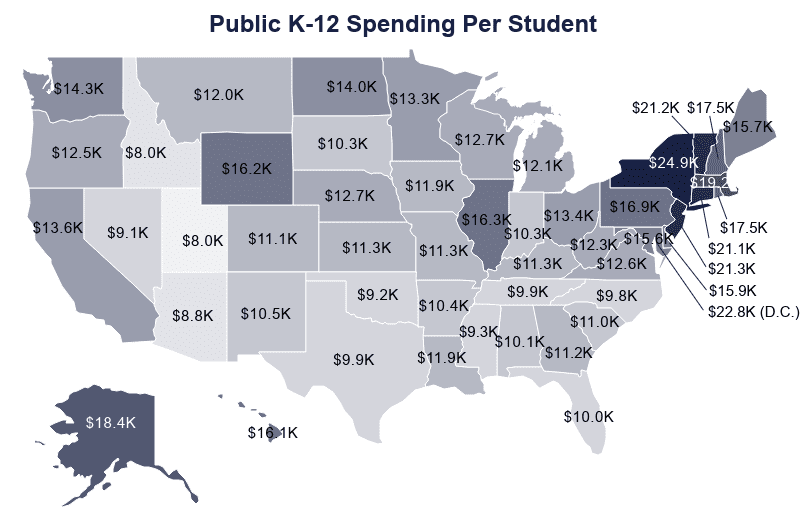
Related research includes K-12 Enrollment and Student Population | Average Cost of Private School | Average Cost of College | Average Cost of Community College
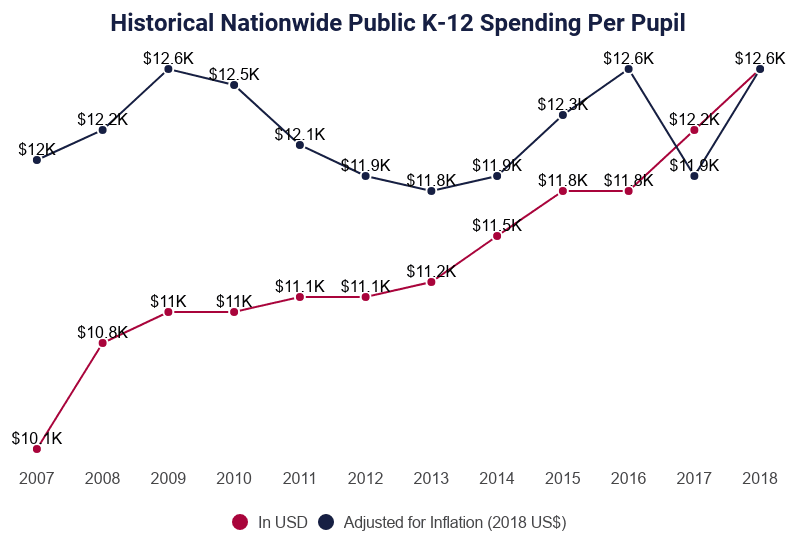
Public Education Spending Statistics
Public education spending at the national level services 50.69 million K-12 students and 14.53 million postsecondary students. It is normal for spending totals to undercut public funding totals to a degree.
- K-12 public schools spend $12,624 per pupil.
- Public K-12 expenditures total $640.0 billion.
- Expenditures are equivalent to 3.41% of taxpayer income.
- K-12 schools nationwide receive $57.34 million total or $1,131 per pupil from the federal government.
- States contribute a total of $344.0 billion to K-12 public education or $6,785 per student.
- Local governments contribute $322.9 billion total or $922 per student.
- Federal public education funding is equivalent to 0.31% of total taxpayer income.
- State and local funding is equivalent to 3.61%.
- Funding for K-12 education totals $734.2 billion, or $14,848 per pupil.
- The difference between spending and funding is $94.29 billion, or $1,860 per pupil.
- At the postsecondary level, colleges and universities spend $26,496 per pupil, 29.23% of which goes toward instruction.
- Federal funding for postsecondary education averages $2,032 per student.
- States and local governments contribute $5,017 and $922, respectively.
- Tuition accounts for 19.88% of all funding.
- 7.09% of all postsecondary funding comes from sales and services of auxiliary enterprises.
- 2-year community colleges spend 16.25% of what 4-year public colleges spend in a year.
U.S. and World Education Spending
In the United States, education spending falls short of benchmarks set by international organizations such as UNESCO, of which the U.S. is a member. The nation puts 11.6% of public funding toward education, well below the international standard 15.00%.
- Schools in the United States spend an average of $12,624 per pupil, which is the fifth-highest amount per pupil among the 37 other developed nations in the Organisation for Economic Co-operation and Development (OECD).
- In terms of a percentage of its gross domestic product (GDP), the United States ranks 12th among OECD members in spending on elementary education.
- The United States does not meet UNESCO's benchmark of a 15.00% share of total public expenditure on education.
- In terms of early childhood education, the United States is one of six (6) countries that do not report any educational spending.
- In terms of postsecondary education, the U.S. spends more than any other country at $33,180 per full-time student.
- Luxembourg spends US$22,700 per pupil, which is more than any of the other OECD nations spend on education.
- African nations spend the highest amount on education in terms of a percentage of GDP.
- At 4.96%, the United States spends a smaller percentage of its GDP on education than other developed nations, which average 5.59% of GDP in educational spending.
| Country | Elementary Schools | Secondary Schools |
|---|---|---|
| Luxembourg | $12,892 | $20,413 |
| Korea | $11,047 | $12,202 |
| France | $7,395 | $11,747 |
| Slovenia | $8,542 | $8,290 |
| Spain | $7,320 | $9,020 |
| Mexico | $2,874 | $3,129 |
| Colombia | $3,178 | $2,817 |
| Indonesia | $1,514 | $1,435 |
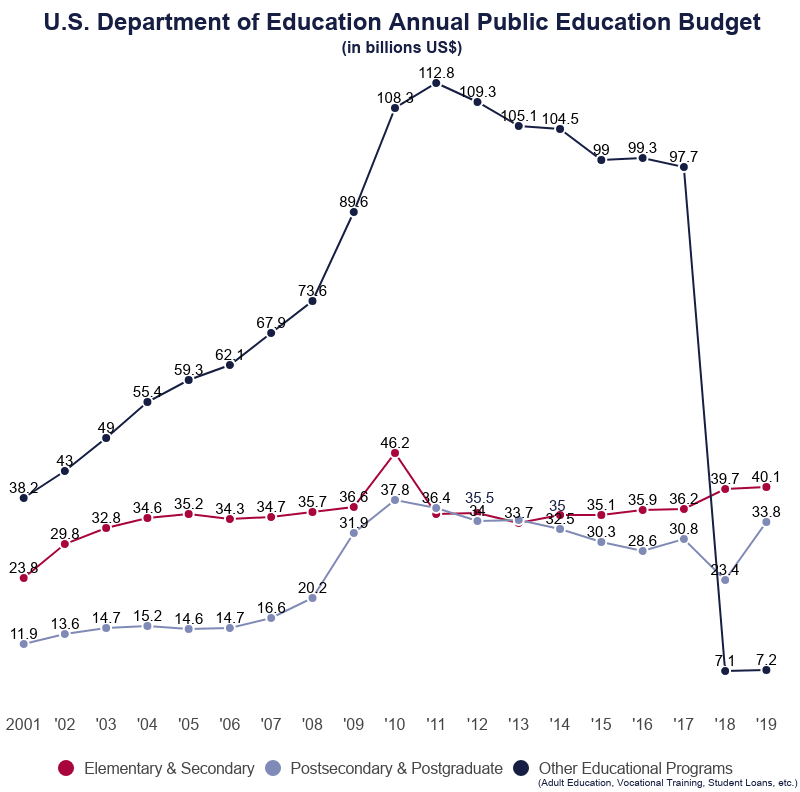
Public Education Spending by State
Education spending refers to the money spent by public schools. This may include teacher and administrator salaries, supplies, building maintenance, field trips, etc. These numbers refer to how much money has a direct impact on public school students.
- New York schools spend the most on K-12 education per pupil.
- California spends the most on postsecondary education.
- New York also spends the second-most on K-12 education in terms of a percentage of local taxpayer income.
- Alaska K-12 schools spend the most in terms of a percentage of taxpayer income.
- District of Columbia K-12 public school students receive the second-most expensive education.
- District of Columbia K-12 schools spend the least in terms of a percentage of local taxpayer income.
- North Carolina makes the most of its funding for K-12 education, having the least funds per pupil leftover after spending on students.
| State | K-12 Spending | Postsecondary Spending |
|---|---|---|
| New York | $23,321 | $26,898 |
| Vermont | $20,370 | $35,954 |
| District of Columbia | $22,847 | $35,229 |
| Connecticut | $20,325 | $34,124 |
| New Jersey | $20,433 | $26,275 |
| Alaska | $17,984 | $32,630 |
| Pennsylvania | $16,339 | $37,614 |
| Massachusetts | $18,375 | $26,048 |
| Hawaii | $15,205 | $35,674 |
| Delaware | $15,049 | $31,348 |
| Wyoming | $16,125 | $25,250 |
| Illinois | $16,066 | $28,545 |
| New Hampshire | $16,674 | $26,076 |
| Michigan | $11,783 | $37,681 |
| Rhode Island | $16,896 | $20,644 |
| Oregon | $11,340 | $37,675 |
| Iowa | $11,656 | $32,041 |
| Maryland | $15,102 | $23,045 |
| Washington | $12,830 | $31,001 |
| North Dakota | $13,550 | $25,021 |
| California | $12,728 | $27,495 |
| New Mexico | $9,987 | $34,366 |
| Nebraska | $12,710 | $26,280 |
| Virginia | $12,243 | $28,052 |
| Maine | $15,070 | $18,501 |
| Ohio | $12,959 | $25,087 |
| Kentucky | $11,133 | $30,872 |
| Alabama | $9,752 | $32,179 |
| Minnesota | $12,846 | $24,280 |
| Wisconsin | $12,466 | $23,589 |
| Colorado | $10,224 | $30,216 |
| Arkansas | $10,184 | $29,953 |
| Montana | $11,561 | $24,513 |
| West Virginia | $11,757 | $22,877 |
| Mississippi | $9,042 | $30,570 |
| Kansas | $11,080 | $20,657 |
| South Carolina | $10,658 | $24,932 |
| Louisiana | $11,691 | $19,619 |
| Utah | $7,478 | $35,246 |
| Missouri | $11,059 | $22,419 |
| Indiana | $10,019 | $25,167 |
| North Carolina | $9,284 | $25,167 |
| Texas | $9,613 | $24,818 |
| Georgia | $10,769 | $20,558 |
| South Dakota | $10,178 | $19,408 |
| Oklahoma | $8,129 | $25,803 |
| Tennessee | $9,546 | $20,401 |
| Florida | $9,616 | $16,445 |
| Arizona | $8,044 | $18,614 |
| Nevada | $8,915 | $16,518 |
| Idaho | $7,610 | $17,631 |
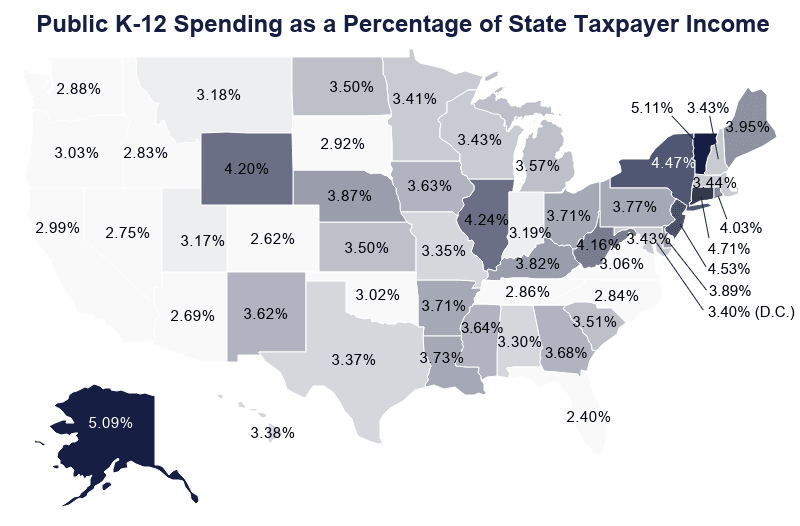
Public Education Funding by State
Educational funding or financing refers to how much money goes into schools, also sometimes referred to as revenue or income. Financing influences spending, but states rarely spend 100% of their public school funding.
- Alaska receives the most funding per pupil from the federal government.
- The District of Columbia receives the second-most federal funding.
- Utah receives the lowest amount per pupil from the federal government.
- Colorado receives the second-lowest amount per pupil in federal funding.
- Vermont's state government spends the most per pupil of any state government to finance education.
- Hawaii supplies the second-most state funding.
- Arizona's state government supplies the lowest amount of educational financing per pupil.
| State | Federal Funding | State & Local Funding |
|---|---|---|
| Alaska | $3,064 | $16,252 |
| District of Columbia | $2,354 | $26,468 |
| South Dakota | $1,649 | $10,262 |
| Montana | $1,646 | $11,316 |
| Louisiana | $1,621 | $11,211 |
| New Mexico | $1,619 | $10,480 |
| North Dakota | $1,508 | $14,327 |
| Hawaii | $1,492 | $16,950 |
| West Virginia | $1,433 | $11,709 |
| Mississippi | $1,398 | $8,735 |
| Kentucky | $1,354 | $11,125 |
| Delaware | $1,316 | $14,732 |
| Vermont | $1,300 | $19,134 |
| Pennsylvania | $1,298 | $17,383 |
| Rhode Island | $1,295 | $16,977 |
| Arkansas | $1,253 | $10,358 |
| Wyoming | $1,235 | $18,074 |
| Texas | $1,227 | $10,412 |
| California | $1,224 | $13,384 |
| Florida | $1,206 | $13,384 |
| Alabama | $1,198 | $9,633 |
| South Carolina | $1,174 | $12,269 |
| Illinois | $1,167 | $17,648 |
| Michigan | $1,164 | $12,745 |
| Arizona | $1,159 | $8,158 |
| Tennessee | $1,158 | $9,342 |
| New York | $1,145 | $25,651 |
| Ohio | $1,078 | $13,912 |
| Georgia | $1,068 | $11,089 |
| Maine | $1,061 | $14,960 |
| North Carolina | $1,059 | $8,672 |
| Nebraska | $1,053 | $13,140 |
| Kansas | $1,052 | $12,463 |
| Missouri | $1,031 | $11,897 |
| Oklahoma | $1,012 | $8,392 |
| Iowa | $987 | $12,705 |
| Indiana | $966 | $11,609 |
| Wisconsin | $965 | $12,815 |
| Oregon | $948 | $12,981 |
| New Hampshire | $948 | $16,950 |
| Maryland | $948 | $16,876 |
| Washington | $940 | $14,226 |
| Connecticut | $938 | $20,933 |
| Massachusetts | $931 | $18,112 |
| New Jersey | $925 | $21,559 |
| Nevada | $901 | $9,671 |
| Virginia | $853 | $12,364 |
| Idaho | $847 | $7,947 |
| Minnesota | $842 | $14,500 |
| Colorado | $772 | $11,524 |
| Utah | $672 | $8,301 |
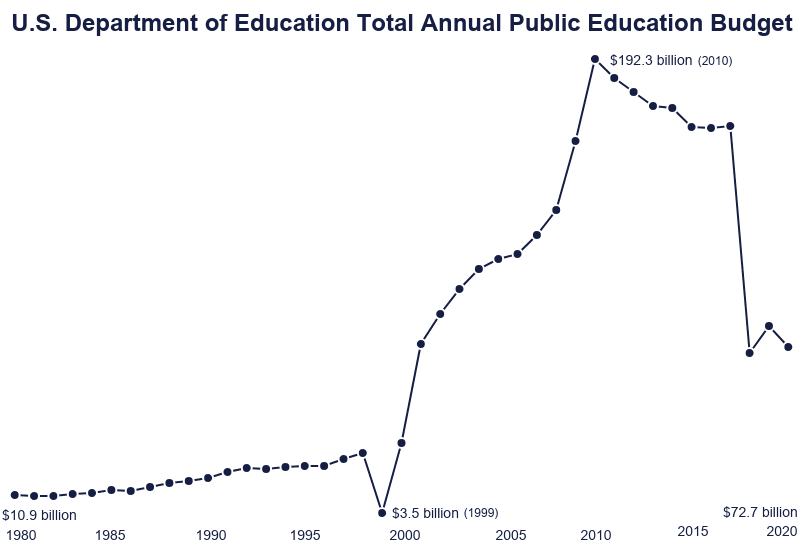
Public Education Spending in Alabama
Alabama spends comparatively little on education in terms of dollars-per-pupil and in terms of percentage of taxpayers' personal income. The state ranks 42nd in funding and 41st in school spending.
- Alabama K-12 schools spend $9,696 per pupil for a total of $7.2 billion annually.
- That is equivalent to 3.30% of taxpayer income.
- Alabama K-12 schools receive $886.3 million from the federal government, or $1,198 per student
- State funding totals $4.43 billion or $5,993 per student.
- Local funding totals $2.69 billion or $3,641 per pupil.
- State and local funding is equivalent to 3.26% of Alabama's taxpayer income.
- Alabama's federal education funding is equivalent to 0.41% of the state's taxpayer income.
- Funding for K-12 education in Alabama totals $8.01 billion or $10,832 per pupil.
- The difference between spending and funding is $798.2 million or $1,079 per pupil.
- At the postsecondary level, colleges and universities spend $32,179 per pupil, 23.64% of which goes toward instruction.
- Federal funding for postsecondary education averages $2,801 per student.
- State funding and local funding average $5,505 per student and $11 per student, respectively.
- Tuition accounts for 22.82% of all funding.
- 6.56% of all postsecondary funding comes from sales and services of auxiliary enterprises.
- Alabama's 2-year community colleges spend 10.24% of what 4-year public colleges spend annually.
Public Education Spending in Alaska
Alaska spends the most on K-12 education in terms of percentage of taxpayer income and ranks 7th overall in the most spending per pupil. Alaska's schools rank 6th in funding and are the most dependent on federal funding.
- Alaskan K-12 public schools spend $17,984 per pupil for a total of $2.36 billion annually.
- Expenditures are equivalent to 5.09% of taxpayer income.
- Alaska K-12 schools receive $401.2 million, or $3,064 per pupil, from the federal government.
- State funding totals $1.58 billion or $12,061 per pupil.
- Local funding totals $548.8 million or $4,191 per pupil.
- State and local funding is equivalent to 4.60% of Alaska's taxpayer income.
- Alaska's federal education funding is equivalent to 0.87% of the state's taxpayer income.
- Funding for K-12 education in Alaska totals $2.53 billion or $19,315 per pupil.
- The difference between spending and funding is $174.3 million or $1,079 per pupil.
- At the postsecondary level, colleges and universities spend $32,630 per pupil, 31.10% of which goes toward instruction.
- Federal funding for postsecondary education averages $4,980 per student.
- State funding and local funding average $13,197 per student and $567 per student, respectively.
- Tuition accounts for 15.80% of all funding.
- 4.59% of all postsecondary funding in Alaska comes from sales and services of auxiliary enterprises.
Public Education Spending in Arizona
Arizona schools spend less on K-12 education than the national average. The state's government also spends less on education per capita. Arizona ranks 49th in spending and in funding.
- Arizona K-12 schools spend $8,044 per pupil for a total of $9.18 billion annually.
- Expenditures are equivalent to 2.69% of taxpayer income.
- Arizona K-12 schools receive $1.32 billion, or $1,159 per pupil, from the federal government.
- State funding totals $5.01 billion or $4,392 per pupil.
- Local funding totals $4.30 billion or $3,766 per pupil.
- State and local funding is equivalent to 2.73% of Arizona's taxpayer income.
- Federal education funding is equivalent to 0.39% of the state's taxpayer income.
- Funding for K-12 education in Arizona totals $10.63 billion or $9,316 per pupil.
- The difference between spending and funding is $1.45 billion or $1,272 per pupil.
- At the postsecondary level, colleges and universities spend $18,614 per pupil, 33.51% of which goes toward instruction.
- Federal funding for postsecondary education averages $1,556 per student.
- State funding and local funding average $2,030 per student and $2,426 per student, respectively.
- Tuition accounts for 34.41% of all funding.
- 6.41% of all postsecondary funding comes from sales and services of auxiliary enterprises.
- Arizona's 2-year community colleges spend 25.68% of what its 4-year public colleges spend in a year.
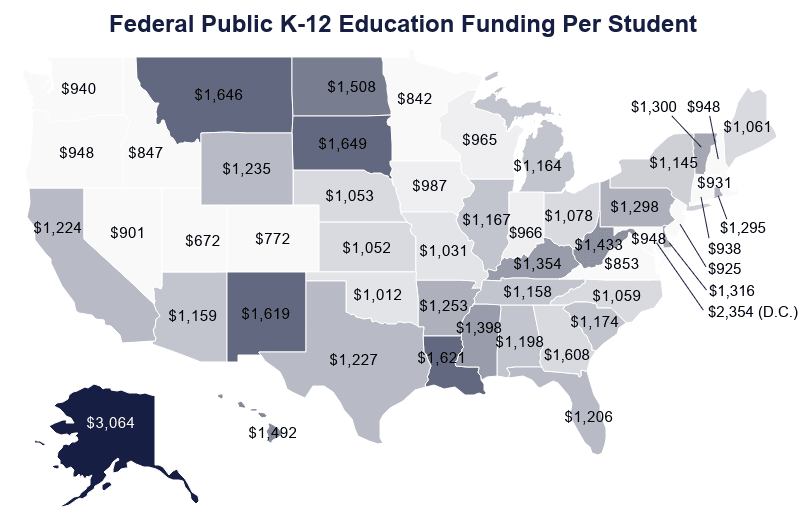
Public Education Spending in Arkansas
Arkansas schools spend less per K-12 pupil than the national average. The state ranks 37th in spending and 41st in funding.
- Arkansas K-12 schools spend $10,184 per pupil for a total of $5.04 billion annually.
- Expenditures are equivalent to 3.71% of taxpayer income.
- Arkansas K-12 schools receive $620.4 million, or $1,253 per pupil, from the federal government.
- State funding totals $2.99 billion or $6,031 per pupil.
- Local funding totals $2.14 billion or $4,327 per pupil.
- State and local funding is equivalent to 3.77% of Arkansas' taxpayer income.
- Arkansas' federal education funding is equivalent to 0.46% of the state's taxpayer income.
- Funding for K-12 education in Arkansas totals $5.75 billion or $11,611 per pupil.
- The difference between spending and funding is $706.5 million or $1,426 per pupil.
- At the postsecondary level, colleges and universities spend $29,953 per pupil, 22.49% of which goes toward instruction.
- Federal funding for postsecondary education averages $1,607 per student.
- State funding and local funding average $5,370 per student and $246 per student, respectively.
- Tuition accounts for 14.24% of all funding.
- 7.30% of all postsecondary funding comes from sales and services of auxiliary enterprises.
- Arkansas' 2-year community colleges spend 12.20% of what its 4-year public colleges spend in a year.
Public Education Spending in California
California receives little federal funding per K-12 student. California ranks 21st in spending and in funding.
- California K-12 schools spend $12,728 per pupil for a total of $79.84 billion annually.
- Expenditures are equivalent to 2.99% of taxpayer income.
- California K-12 schools receive $7.68 billion, or $1,224 per pupil, from the federal government.
- State funding totals $51.78 billion or $8,254 per pupil.
- Local funding totals $32.18 billion or $5,130 per pupil.
- State and local funding is equivalent to3.14% of California's taxpayer income.
- California's federal education funding is equivalent to 0.29% of the state's taxpayer income.
- Funding for K-12 education in California totals $91.63 billion or $14,608 per pupil.
- The difference between spending and funding is $11.79 billion or $1,880 per pupil.
- At the postsecondary level, colleges and universities spend $27,495 per pupil, 25.67% of which goes toward instruction.
- Federal funding for postsecondary education averages $5,139 per student.
- State funding and local funding average $5,139 per student and $1,799 per student, respectively.
- Tuition accounts for 12.69% of all funding.
- 3.87% of all postsecondary funding comes from sales and services of auxiliary enterprises.
- California's 2-year community colleges spend 25.26% of what its 4-year public colleges spend in a year.
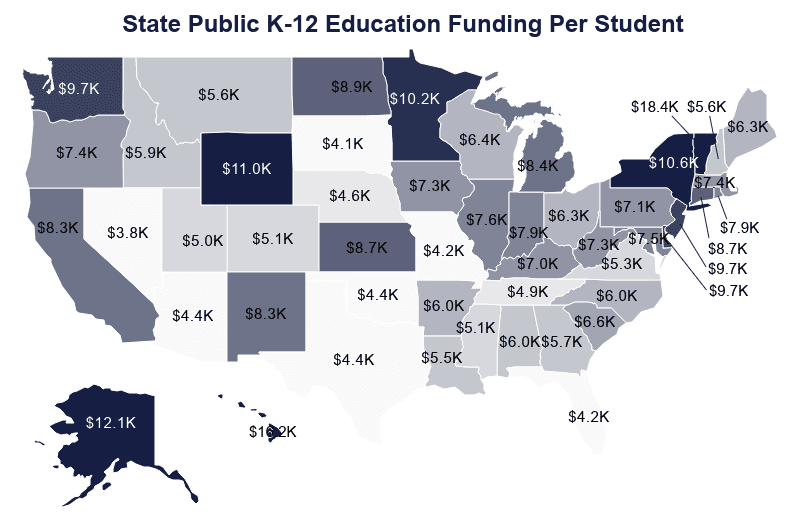
Public Education Spending in Colorado
Colorado K-12 schools spend less per pupil than the national average. The federal government also spends less per capita on Colorado's education. Colorado ranks 36th in spending and in funding.
- K-12 schools spend $10,224 per pupil for a total of $9.32 billion annually.
- Expenditures are equivalent to 2.62% of taxpayer income.
- Colorado K-12 schools receive $703.8 million, or $772 per pupil from the federal government.
- State funding totals $4.68 billion or $5,133 per pupil.
- Local funding totals $5.83 billion, or $6,391 per pupil.
- State and local funding is equivalent to 2.95% of Colorado's taxpayer income.
- Colorado's federal education funding is equivalent to 0.20% of the state's taxpayer income.
- Funding for K-12 education in Colorado totals $11.21 billion, or $12,296 per pupil.
- The difference between spending and funding is $1.89 billion, or $2,072 per pupil.
- At the postsecondary level, colleges and universities spend $30,216 per pupil, 29.66% of which goes toward instruction.
- Federal funding for postsecondary education averages $3,823 per student.
- State funding and local funding average $159 per student and $359 per student, respectively.
- Tuition accounts for 30.34% of all funding.
- 8.21% of all postsecondary funding comes from sales and services of auxiliary enterprises.
- Colorado's 2-year community colleges spend 4.87% of what its 4-year public colleges spend in a year.
Public Education Spending in Connecticut
Connecticut K-12 schools spend more per pupil than most other states. The state receives comparatively little in federal funding. Connecticut ranks 5th in spending and 4th in funding.
- K-12 schools spend $20,325 per pupil for a total of $10.70 billion annually.
- Expenditures are equivalent to 4.71% of taxpayer income.
- Connecticut K-12 schools receive $494.0 million, or $938 per pupil, from the federal government.
- State funding totals $4.58 billion or $8,701 per pupil.
- Local funding totals $6.44 billion or $12,233 per pupil.
- State and local funding is equivalent to 4.86% of Connecticut's taxpayer income.
- Federal education funding is equivalent to 0.22% of the state's taxpayer income.
- Funding for K-12 education in Connecticut totals $11.52 billion or $21,871 per pupil.
- The difference between spending and funding is $814.4 million, or $1,546 per pupil.
- At the postsecondary level, colleges and universities spend $34,124 per pupil, 29.93% of which goes toward instruction.
- Federal funding for postsecondary education averages $1,545 per student.
- State funding averages $9,822 per student.
- Tuition accounts for 19.54% of all funding.
- 8.20% of all postsecondary funding comes from sales and services of auxiliary enterprises.
- Connecticut's 2-year community colleges spend 15.26% of what its 4-year public colleges spend in a year.
Public Education Spending in Delaware
Delaware spends more per K-12 pupil than the national average. The state ranks 16th in spending and 15th in funding.
- Delaware K-12 schools spend $15,049 per pupil for a total of $2.08 billion annually.
- Expenditures are equivalent to 3.89% of taxpayer income.
- Delaware K-12 schools receive $182.1 million, or $1,316 per pupil, from the federal government.
- State funding totals $1.34 billion or $9,715 per pupil.
- Local funding totals $694.4 million or $5,017 per pupil.
- State and local funding is equivalent to 3.81% of Delaware's taxpayer income.
- Federal education funding is equivalent to 0.34% of the state's taxpayer income.
- Funding for Delaware K-12 education totals $2.22 billion or $16,048 per pupil.
- The difference between spending and funding is $138.3 million, or $999 per pupil.
- At the postsecondary level, colleges and universities spend $31,348 per pupil, 44.33% of which goes toward instruction.
- Federal funding for postsecondary education averages $3,220 per student.
- State funding averages $5,556 per student.
- Tuition accounts for 36.90% of all funding.
- 11.41% of all postsecondary funding in Delaware comes from sales and services of auxiliary enterprises.
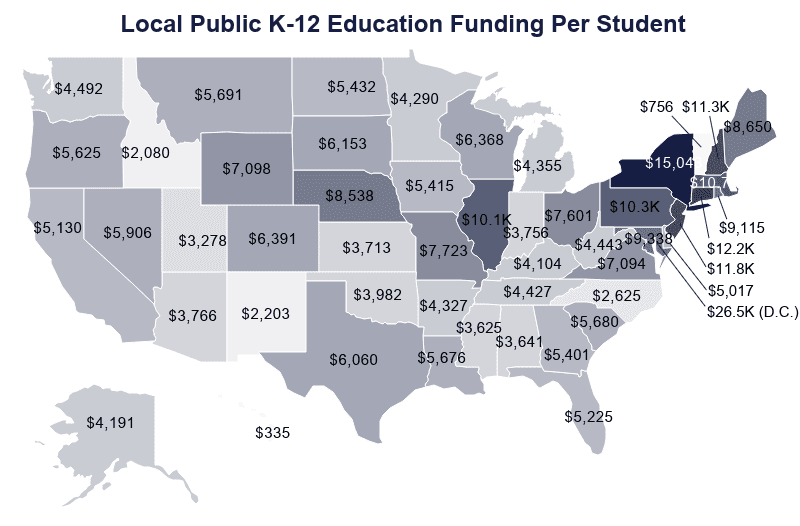
Public Education Spending in the District of Columbia
While District of Columbia K-12 schools spend more per pupil than most schools nationwide, these schools spend the least in terms of a percentage of taxpayer income. D.C. ranks 1st in funding and 2nd in spending. D.C. schools are the most dependent on local funding, and receive the second-most federal funding per student.
- District of Columbia K-12 schools spend $22,847 per pupil for a total of $2.02 billion annually.
- Expenditures are equivalent to 3.40% of taxpayer income.
- District of Columbia K-12 schools receive $208.3 million, or $2,354 per pupil from the federal government.
- Local funding totals $2.34 billion, or $26,468 per pupil.
- Local funding is equivalent to 3.94% of the District of Columbia's taxpayer income.
- Federal education funding is equivalent to 0.35% of local taxpayer income.
- Funding for K-12 education in the District of Columbia totals $2.55 billion, or $28,822 per pupil.
- The difference between spending and funding is $528.7 million, or $5,975 per pupil.
- At the postsecondary level, colleges and universities spend $ per pupil, % of which goes toward instruction.
- Federal funding for postsecondary education averages $ per student.
- State funding averages $17,778 per student.
- Tuition accounts for 21.10% of all funding.
- 0.26% of all postsecondary funding in D.C. comes from sales and services of auxiliary enterprises.
Public Education Spending in Florida
Florida receives the third-largest amount of federal K-12 education funding. The state government funds education at a lower per-capita rate. Florida ranks 42nd in spending and 43rd in funding.
- Florida K-12 schools spend $9,616 per pupil for a total of $27.37 billion annually.
- Expenditures are equivalent to 2.40% of taxpayer income.
- Florida K-12 schools receive $3.43 billion or $1,206 per pupil, from the federal government.
- State funding totals $11.81 billion or $4,150 per pupil.
- Local funding totals $14.87 billion or $5,225 per pupil.
- State and local funding is equivalent to 2.34% of Florida's taxpayer income.
- Federal education funding is equivalent to 0.30% of the state's taxpayer income.
- Funding for K-12 education in Florida totals $30.12 billion or $10,581 per pupil.
- Federal funding for postsecondary schools is $2.75 billion or $965 per pupil.
- At the postsecondary level, colleges and universities spend $16,445 per pupil, 32.35% of which goes toward instruction.
- Among postsecondary schools, federal funding averages $1,471 per student.
- State funding averages $5,241 per student.
- Tuition accounts for 18.63% of all funding.
- 6.83% of all postsecondary funding comes from sales and services of auxiliary enterprises.
- Florida's 2-year community colleges spend 1.47% of what its 4-year public colleges spend in a year.
Public Education Spending in Georgia
Georgia K-12 schools spend less per pupil than the nationwide average. Georgia ranks 34th in spending and 37th in funding.
- Georgia K-12 schools spend $10,769 per pupil for a total of $19.03 billion annually.
- Expenditures are equivalent to 3.68% of taxpayer income.
- Georgia K-12 schools receive $1.89 billion, or $1,068 per pupil, from the federal government.
- State funding totals $10.05 billion or $5,688 per pupil.
- Local funding totals $9.54 billion, or $5,401.
- State and local funding is equivalent to 3.79% of Georgia's taxpayer income.
- Federal funding is equivalent to 0.36% of the state's taxpayer income.
- Funding for K-12 education in Georgia totals $21.48 billion or $12,157 per pupil.
- The difference between spending and funding is $2.45 billion, or $1,388 per pupil.
- At the postsecondary level, colleges and universities spend $20,558 per pupil, 28.95% of which goes toward instruction.
- Federal funding for postsecondary education averages $2,153 per student.
- State funding and local funding average $5,604 per student and $2.00 per student, respectively.
- Tuition accounts for 24.57% of all funding.
- 10.01% of all postsecondary funding comes from sales and services of auxiliary enterprises.
- Georgia's 2-year community colleges spend 11.67% of what its 4-year public colleges spend in a year.
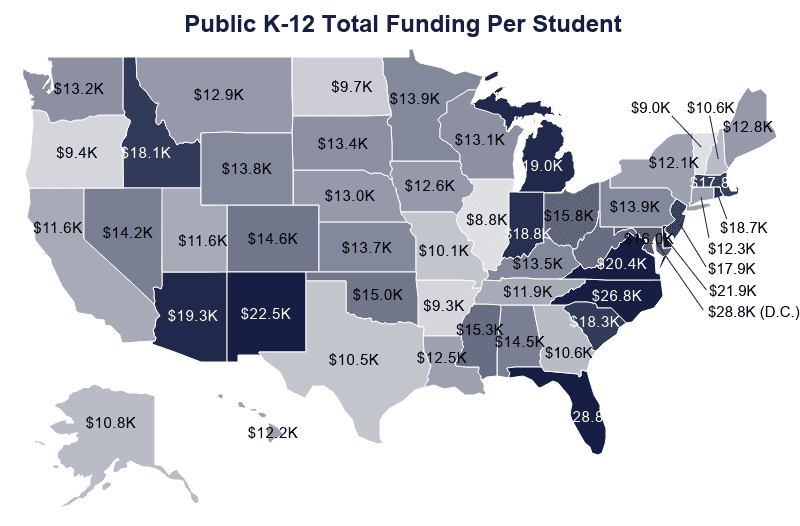
Public Education Spending in Hawaii
Hawaii spends more per K-12 pupil than most other states. The state ranks 13th in spending and 12th in funding.
- Hawaii K-12 schools spend $15,205 per pupil for a total of $2.76 billion annually.
- Expenditures are equivalent to 3.38% of taxpayer income.
- K-12 schools receive $260.5 million or $1,492 per pupil from the federal government.
- State funding totals $2.94 billion or $16,223 per pupil.
- Local funding totals $60.79 billion or $335 per pupil.
- State and local funding is equivalent to 3.68% of Hawaii's taxpayer income.
- Federal education funding is equivalent to 0.33% of the state's taxpayer income.
- Funding for K-12 education in Hawaii totals $3.27 billion, or $18,051 per pupil.
- The difference between spending and funding is $515.9 million, or $2,849 per pupil.
- At the postsecondary level, colleges and universities spend $35,674 per pupil, 34.68% of which goes toward instruction.
- Federal funding for postsecondary education averages $5,978 per student.
- State funding averages $9,501 per student.
- Tuition accounts for 14.05% of all funding.
- 5.43% of all postsecondary funding comes from sales and services of auxiliary enterprises.
- Hawaii's 2-year community colleges spend 18.85% of what its 4-year public colleges spend in a year.
Public Education Spending in Idaho
Idaho ranks 50th in terms of K-12 spending, and Idaho schools receive the least funding of all.
- Idaho K-12 schools spend $7,610 per pupil for a total of $2.36 billion annually.
- Expenditures are equivalent to 2.83% of taxpayer income.
- Idaho K-12 schools receive $263.0 million, or $847 per pupil, from the federal government.
- State funding totals $1.82 billion or $5,866 per pupil.
- Local funding totals $646.0 million, or $2,080 per pupil.
- State and local funding is equivalent to2.95% of Idaho's taxpayer income.
- Idaho's federal education funding is equivalent to 0.31% of the state's taxpayer income.
- Funding for K-12 education in Idaho totals $2.73 billion, or $8,794 per pupil.
- The difference between spending and funding is $367.6 million, or $1,184 per pupil.
- At the postsecondary level, colleges and universities spend $17,631 per pupil, 36.80% of which goes toward instruction.
- Federal funding for postsecondary education averages $1,726 per student.
- State funding and local funding average $5,601 per student and $407 per student, respectively.
- Tuition accounts for 26.42% of all funding.
- 7.58% of all postsecondary funding comes from sales and services of auxiliary enterprises.
- Idaho's 2-year community colleges spend 19.47% of what its 4-year public colleges spend in a year.
Public Education Spending in Illinois
Illinois ranks 12th in K-12 school spending and 9th in funding. Illinois schools receive more state and local funding in terms of a percentage of taxpayer income.
- Illinois K-12 schools spend $16,066 per pupil for a total of $31.85 billion annually.
- Expenditures are equivalent to 4.24% of taxpayer income.
- Illinois K-12 schools receive $2.31 billion, or $1,167 per pupil, from the federal government.
- State funding totals $14.98 billion or $7,557 per pupil.
- Local funding totals $20.00 billion or $10,091 per pupil.
- State and local funding is equivalent to4.66% of Illinois's taxpayer income.
- Federal education funding is equivalent to 0.31% of the state's taxpayer income.
- Funding for K-12 education in Illinois totals $37.30 billion or $18,815 per pupil.
- The difference between spending and funding is $5.45 billion,or $2,748 per pupil.
- At the postsecondary level, colleges and universities spend $28,545 per pupil, 34.44% of which goes toward instruction.
- Federal funding for postsecondary education averages $1,716 per student.
- State funding and local funding average $4,907 per student and $2,504 per student, respectively.
- Tuition accounts for 17.00% of all funding.
- 5.95% of all postsecondary funding comes from sales and services of auxiliary enterprises.
- Illinois' 2-year community colleges spend 35.67% of what its 4-year public colleges spend in a year.
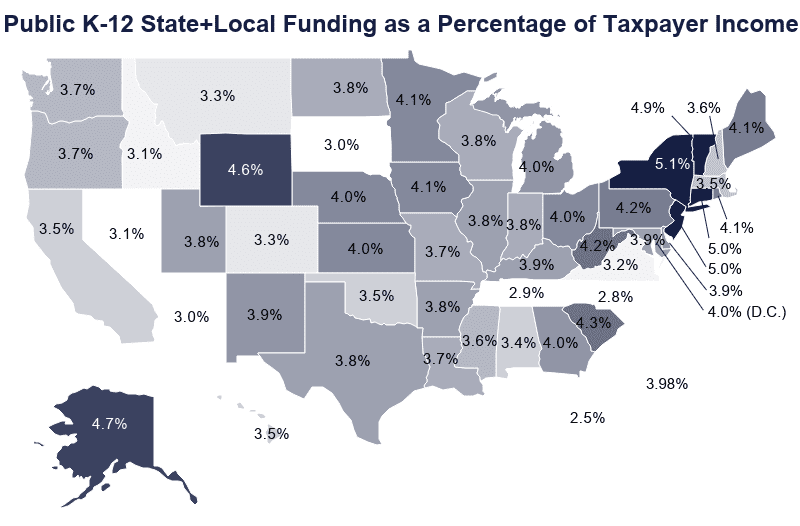
Public Education Spending in Indiana
Indiana ranks 39th in K-12 school spending and 34th in funding. The state receives relatively little from the federal government.
- Indiana K-12 schools spend $10,019 per pupil for a total of $10.58 billion annually.
- Expenditures are equivalent to 3.19% of taxpayer income.
- Indiana K-12 schools receive $1.02 million, or $966 per pupil, from the federal government.
- State funding totals $8.29 billion or $7,853 per pupil.
- Local funding totals $3.96 billion or $3,756 per pupil.
- State and local funding is equivalent to 3.70% of Indiana's taxpayer income.
- Federal education funding is equivalent to 0.31% of the state's taxpayer income.
- Funding for K-12 education in Indiana totals $13.27 billion or $12,574 per pupil.
- The difference between spending and funding is $2.70 billion or $2,556 per pupil.
- At the postsecondary level, colleges and universities spend $23,459 per pupil, 41.06% of which goes toward instruction.
- Federal funding for postsecondary education averages $2,028 per student.
- State funding and local funding average $5,290 per student and $30.00 per student, respectively.
- Tuition accounts for 33.19% of all funding.
- 11.00% of all postsecondary funding comes from sales and services of auxiliary enterprises.
- Indiana's 2-year community colleges spend 8.34% of what its 4-year public colleges spend in a year.
Public Education Spending in Iowa
Iowa ranks 28th in K-12 school spending and 26th in funding. Iowa spends more when taken as a percentage of taxpayer income.
- Iowa K-12 schools spend $11,656 per pupil for a total of $6.00 billion annually.
- Expenditures are equivalent to 3.63% of taxpayer income.
- Iowa K-12 schools receive $508.1 million, or $987 per pupil, from the federal government.
- State funding totals $3.75 billion or $7,290 per pupil.
- Local funding totals $2.79 billion or $5,415 per pupil.
- State and local funding is equivalent to 3.96% of Iowa's taxpayer income.
- Federal education funding is equivalent to 0.31% of the state's taxpayer income.
- Funding for K-12 education in Iowa totals $7.05 billion or $13,692 per pupil.
- The difference between spending and funding is $1.05 billion or $2,036 per pupil.
- At the postsecondary level, colleges and universities spend $32,041 per pupil, 20.62% of which goes toward instruction.
- Federal funding for postsecondary education averages $2,516 per student.
- State funding and local funding average $4,048 per student and $770 per student, respectively.
- Tuition accounts for 19.88% of all funding.
- 8.44% of all postsecondary funding comes from sales and services of auxiliary enterprises.
- Iowa's 2-year community colleges spend 17.53% of what its 4-year public colleges spend in a year.
Public Education Spending in Kansas
Kansas ranks 32nd in K-12 schools spending and 27th in funding. Kansas schools are more dependent on state funding.
- K-12 schools spend $11,080 per pupil for a total of $5.52 billion annually.
- Expenditures are equivalent to 3.50% of taxpayer income.
- Kansas K-12 schools receive $523.7 million, or $1,052 per pupil, from the federal government.
- State funding totals $4.35 billion or $8,749 per pupil.
- Local funding totals $1.85 billion or $3,713 per pupil.
- State and local funding is equivalent to 3.94% of Kansas' taxpayer income.
- Federal education funding is equivalent to 0.33% of the state's taxpayer income.
- Funding for K-12 education in Kansas totals $6.73 billion or $13,515 per pupil.
- The difference between spending and funding is $1.21 billion or $2,435 per pupil.
- At the postsecondary level, colleges and universities spend $20,657 per pupil, 35.13% of which goes toward instruction.
- Federal funding for postsecondary education averages $1,769 per student.
- State funding and local funding average $4,098 per student and $1,714 per student, respectively.
- Tuition accounts for 25.39% of all funding.
- 12.24% of all postsecondary funding comes from sales and services of auxiliary enterprises.
- Kansas' 2-year community colleges spend 26.16% of what its 4-year public colleges spend in a year.
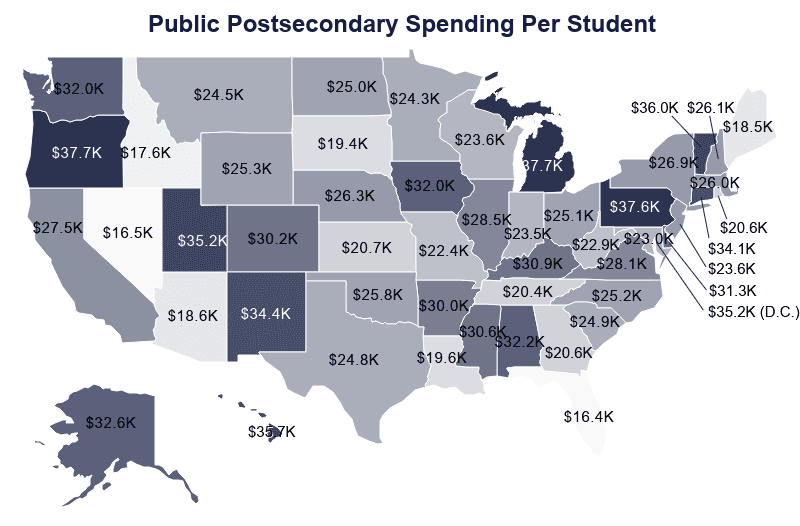
Public Education Spending in Kentucky
Kentucky K-12 schools rank 31st in spending but 35th in funding.
- K-12 schools spend $11,133 per pupil for a total of $7.55 billion annually.
- Expenditures are equivalent to 3.82% of taxpayer income.
- Kentucky K-12 schools receive $918.1 million or $1,354 per pupil, from the federal government.
- State funding totals $4.76 billion or $7,022 per pupil.
- Local funding totals $2.78 billion or $4,104 per pupil.
- State and local funding is equivalent to 3.81% of Kentucky's taxpayer income.
- Federal education funding is equivalent to 0.46% of the state's taxpayer income.
- Funding for K-12 education in Kentucky totals $8.46 billion or $12,480 per pupil.
- The difference between spending and funding is $912.9 million or $1,347 per pupil.
- At the postsecondary level, colleges and universities spend $30,872 per pupil, 21.79% of which goes toward instruction.
- Federal funding for postsecondary education averages $2,194 per student.
- State funding and local funding average $4,404 per student and $127 per student, respectively.
- Tuition accounts for 17.22% of all funding.
- 6.15% of all postsecondary funding comes from sales and services of auxiliary enterprises.
- Kentucky's 2-year community colleges spend 10.04% of what its 4-year public colleges spend in a year.
Public Education Spending in Louisiana
Louisiana K-12 schools rank 27th in terms of spending and 33rd in funding.
- K-12 schools spend $11,691 per pupil for a total of $8.32 billion annually.
- Expenditures are equivalent to 3.73% of taxpayer income.
- Louisiana K-12 schools receive $1.15 billion, or $1,621 per pupil, from the federal government.
- State funding totals $3.94 billion or $5,536 per pupil.
- Local funding totals $4.04 billion $5,676 per pupil.
- State and local funding is equivalent to 3.58% of Louisiana's taxpayer income.
- Federal funding for education is equivalent to 0.52% of the state's taxpayer income.
- Funding for K-12 education in Louisiana totals $9.13 billion or $12,832 per pupil.
- The difference between spending and funding is $812.0 million or $1,141 per pupil.
- At the postsecondary level, colleges and universities spend $19,619 per pupil, 32.41% of which goes toward instruction.
- Federal funding for postsecondary education averages $1,415 per student.
- State funding averages $3,705 per student.
- Tuition accounts for 27.46% of all funding.
- 9.24% of all postsecondary funding comes from sales and services of auxiliary enterprises.
- Louisiana's 2-year community colleges spend 12.32% of what its 4-year public colleges spend in a year.
Public Education Spending in Maine
Maine K-12 schools rank 15th in spending and 16th in funding.
- K-12 schools spend $15,070 per pupil for a total of $2.72 billion annually.
- Expenditures are equivalent to 3.95% of taxpayer income.
- Maine K-12 schools receive $191.4 million, or $1,061 per pupil, from the federal government.
- State funding totals $1.14 billion or $6,310 per pupil.
- Local funding totals $1.56 billion or $8,650 per pupil.
- State and local funding is equivalent to 3.92% of Maine taxpayer income.
- Federal education funding is equivalent to 0.28% of the state's taxpayer income.
- Funding for K-12 education in Maine totals $2.89 billion or $16,021 per pupil.
- The difference between spending and funding is $171.5 million or $951 per pupil.
- At the postsecondary level, colleges and universities spend $18,501 per pupil, 32.03% of which goes toward instruction.
- Federal funding for postsecondary education averages $1,246 per student.
- State funding averages $5,724 per student.
- Tuition accounts for 26.98% of all funding.
- 9.09% of all postsecondary funding comes from sales and services of auxiliary enterprises.
- Maine's 2-year community colleges spend 16.76% of what its 4-year public colleges spend in a year.
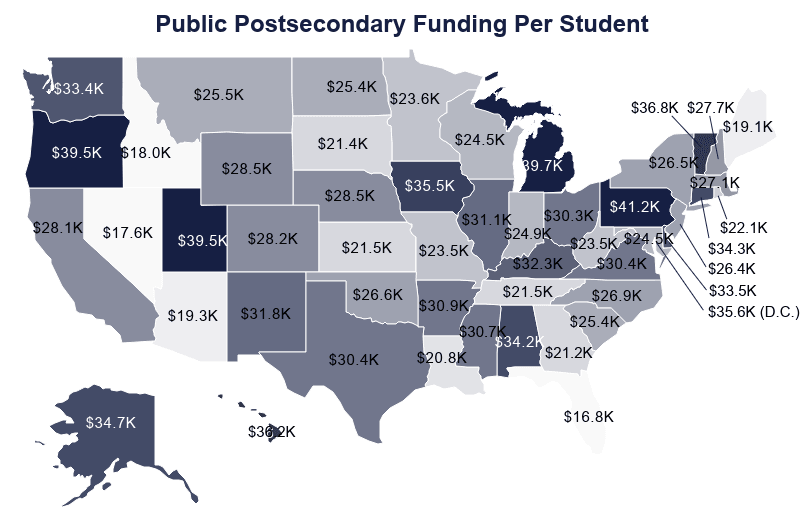
Public Education Spending in Maryland
Maryland K-12 schools rank 14th in spending and in funding.
- K-12 schools spend $15.102 per pupil for a total of $13.54 billion annually.
- Expenditures are equivalent to 3.43% of taxpayer income.
- Maryland K-12 schools receive $849.9 million, or $948 per pupil, from the federal government.
- State funding totals $6.76 billion or $7,538 per pupil among its public schools.
- Local funding totals $8.37 billion or $9,338 per pupil.
- State and local funding is equivalent to 3.84% of Maryland taxpayer income.
- Federal education funding is equivalent to 0.22% of the state's taxpayer income.
- Funding for K-12 education in Maryland totals $15.98 billion or $17,824 per pupil.
- The difference between spending and funding is $2.44 billion or $2,722 per pupil.
- At the postsecondary level, colleges and universities spend $23,045 per pupil, 30.20% of which goes toward instruction.
- Federal funding for postsecondary education averages $2,565 per student.
- State funding and local funding average $5,810 per student and $1,375 per student, respectively.
- Tuition accounts for 24.04% of all funding.
- 10.05% of all postsecondary funding comes from sales and services of auxiliary enterprises.
- Maryland's 2-year community colleges spend 26.14% of what its 4-year public colleges spend in a year.
Public Education Spending in Massachusetts
Massachusetts ranks 6th in K-12 school spending and 8th in funding. The state receives relatively little funding from the federal government.
- Massachusetts K-12 schools spend $18,375 per pupil for a total of $17.68 billion annually.
- Expenditures are equivalent to 3.44% of taxpayer income.
- Massachusetts K-12 schools receive $895.9 million, or $931 per pupil, from the federal government.
- State funding totals $7.10 billion or $7,378 per pupil.
- Local funding totals $10.33 billion or $10,734 per pupil.
- State and local funding is equivalent to 3.39% of Massachusetts taxpayer income.
- Federal education funding is equivalent to 0.17% of the state's taxpayer income.
- Funding for K-12 education in Massachusetts totals $18.33 billion or $19,043 per pupil.
- The difference between spending and funding is $642.5 million or $668 per pupil.
- At the postsecondary level, colleges and universities spend $26,048 per pupil, 33.97% of which goes toward instruction.
- Federal funding for postsecondary education averages $1,945 per student.
- State funding averages $7,035 per student.
- Tuition accounts for 26.75% of all funding.
- 10.33% of all postsecondary funding comes from sales and services of auxiliary enterprises.
- Massachusetts' 2-year community colleges spend 20.25% of what its 4-year public colleges spend in a year.
Public Education Spending in Michigan
Michigan ranks 25th in K-12 school spending and 24th in funding.
- Michigan K-12 schools spend $11,783 per pupil for a total of $17.7 billion annually.
- Expenditures are equivalent to 3.57% of taxpayer income.
- Michigan K-12 schools receive $1.75 billion, or $1,164 per pupil, from the federal government.
- State funding totals $12.6 billion or $8,389 per pupil.
- Local funding totals $6.55 billion or $4,355 per pupil.
- State and local funding is equivalent to 3.86% of Michigan's taxpayer income.
- Federal education funding is equivalent to 0.35% of the state's taxpayer income.
- Funding for K-12 education in Michigan totals $20.9 billion or $13,909 per pupil.
- The difference between spending and funding is $3.20 billion or $2,126 per pupil.
- At the postsecondary level, colleges and universities spend $37,681 per pupil, 25.27% of which goes toward instruction.
- Federal funding for postsecondary education averages $3,412 per student.
- State funding and local funding average $3,965 per student and $1,229 per student, respectively.
- Tuition accounts for 23.59% of all funding.
- 6.63% of all postsecondary funding comes from sales and services of auxiliary enterprises.
- Michigan's 2-year community colleges spend 9.10% of what its 4-year public colleges spend in a year.
Public Education Spending in Minnesota
Minnesota ranks 19th in K-12 school spending and 18th in funding. Most educational funding comes from the state government.
- Minnesota K-12 schools spend $12,846 per pupil for a total of $11.42 billion annually.
- Expenditures are equivalent to 3.41% of taxpayer income.
- Minnesota K-12 schools receive $749.1 million, or $842 per pupil, from the federal government.
- State funding totals $9.08 billion or $10,211 per pupil.
- Local funding totals $3.81 billion or $4,290 per pupil.
- State and local funding is equivalent to 3.85% of Minnesota's taxpayer income.
- Federal education funding is equivalent to 0.22% of the state's taxpayer income.
- Funding for K-12 education in Minnesota totals $13.64 billion or $15,343 per pupil.
- The difference between spending and funding is $2.22 billion or $2,496 per pupil.
- At the postsecondary level, colleges and universities spend $24,280 per pupil, 29.59% of which goes toward instruction.
- Federal funding for postsecondary education averages $1,863 per student.
- State funding averages $5,691 per student.
- Tuition accounts for 23.35% of all funding.
- 11.69% of all postsecondary funding comes from sales and services of auxiliary enterprises.
- Minnesota's 2-year community colleges spend 24.51% of what its 4-year public colleges spend in a year.
Public Education Spending in Mississippi
Mississippi ranks 476th in K-12 school spending and in funding.
- Mississippi K-12 schools spend $9,042 per pupil for a total of $4.26 billion annually.
- Expenditures are equivalent to 3.64% of taxpayer income.
- Mississippi K-12 schools receive $658.7 million, or $1,398 per pupil, from the federal government.
- State funding totals $2.41 billion or $5,110 per pupil.
- Local funding totals $1.71 billion or $3,625 per pupil.
- State and local funding is equivalent to 3.52% of Mississippi's taxpayer income.
- Federal education funding is equivalent to 0.56% of the state's taxpayer income.
- Funding for K-12 education in Mississippi totals $4.78 billion or $10,132 per pupil.
- The difference between spending and funding is $514.0 million or $1,091 per pupil.
- At the postsecondary level, colleges and universities spend $30,570 per pupil, 24.56% of which goes toward instruction.
- Federal funding for postsecondary education averages $2,328 per student.
- State funding and local funding average $5,982 per student and $491 per student, respectively.
- Tuition accounts for 15.97% of all funding.
- 8.01% of all postsecondary funding comes from sales and services of auxiliary enterprises.
- Mississippi's 2-year community colleges spend 25.45% of what its 4-year public colleges spend in a year.
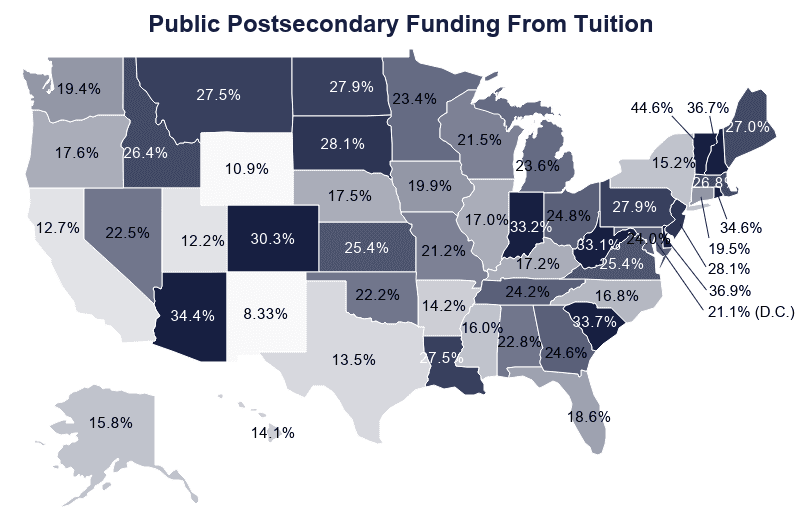
Public Education Spending in Missouri
Missouri ranks 33rd in K-12 school spending and 32nd in funding.
- Missouri K-12 schools spend $11,059 per pupil for a total of $10.10 billion annually.
- Expenditures are equivalent to 3.35% of taxpayer income.
- Missouri K-12 schools receive $941.5 million, or $1,031 per pupil, from the federal government.
- State funding totals $3.81 billion or $4,173 per pupil.
- Local funding totals $7.05 billion or $7,723 per pupil.
- State and local funding is equivalent to 3.60% of Missouri's taxpayer income.
- Federal education funding is equivalent to 0.31% of the state's taxpayer income.
- Funding for K-12 education in Missouri totals $11.81 billion or $12,927 per pupil.
- The difference between spending and funding is $1.71 billion or $1,869 per pupil.
- At the postsecondary level, colleges and universities spend $22,419 per pupil, 29.41% of which goes toward instruction.
- Federal funding for postsecondary education averages $950 per student.
- State funding and local funding average $3,734 per student and $702 per student, respectively.
- Tuition accounts for 21.23% of all funding.
- 15.39% of all postsecondary funding comes from sales and services of auxiliary enterprises.
- Missouri's 2-year community colleges spend 16.82% of what its 4-year public colleges spend in a year.
Public Education Spending in Montana
Montana ranks 29th in K-12 school spending and 31st in funding.
- Montana K-12 schools spend $11,561 per pupil for a total of $1.72 billion annually.
- Expenditures are equivalent to 3.18% of taxpayer income.
- Montana K-12 schools receive $244.9 million, or $1,646 per pupil, from the federal government.
- State funding totals $837.4 million or $5,626 per pupil.
- Local funding totals $847.0 million or $5,691 per pupil.
- State and local funding is equivalent to 3.12% of Montana's taxpayer income.
- Federal education funding is equivalent to 0.5% of the state's taxpayer income.
- Funding for K-12 education in Montana totals $1.93 billion, or $12,962 per pupil.
- The difference between spending and funding is $208.6 million, or $1,402 per pupil.
- At the postsecondary level, colleges and universities spend $24,513 per pupil, 29.89% of which goes toward instruction.
- Federal funding for postsecondary education averages $3,862 per student.
- State funding and local funding average $5,162 per student and $247 per student, respectively.
- Tuition accounts for 27.48% of all funding.
- 9.33% of all postsecondary funding comes from sales and services of auxiliary enterprises.
- Montana's 2-year community colleges spend 11.32% of what its 4-year public colleges spend in a year.
Public Education Spending in Nebraska
Nebraska ranks 22nd in K-12 school spending and in funding.
- Nebraska K-12 schools spend $12,710 per pupil for a total of $4.15 billion annually.
- Expenditures are equivalent to 3.87% of taxpayer income.
- Nebraska K-12 schools receive $343.7 million, or $1,053 per pupil, from the federal government.
- State funding totals $1.50 billion or $4,602 per pupil.
- Local funding totals $2.79 billion or $8,538 per pupil.
- State and local funding is equivalent to 4.01% of Nebraska's taxpayer income.
- Federal education funding is equivalent to 0.32% of the state's taxpayer income.
- Funding for K-12 education in Nebraska totals $4.63 billion or $14,193 per pupil.
- The difference between spending and funding is $484.1 million or $1,483 per pupil.
- At the postsecondary level, colleges and universities spend $26,280 per pupil, 32.90% of which goes toward instruction.
- Federal funding for postsecondary education averages $2,734 per student.
- State funding and local funding average $7,023 per student and $1,788 per student, respectively.
- Tuition accounts for 17.50% of all funding.
- 13.11% of all postsecondary funding comes from sales and services of auxiliary enterprises.
- Nebraska's 2-year community colleges spend 20.38% of what its 4-year public colleges spend in a year.
Public Education Spending in Nevada
Nevada K-12 schools rank 47th in spending and 44th in funding.
- Nevada K-12 schools spend $8,915 per pupil for a total of $4.39 billion annually.
- Expenditures are equivalent to 2.75% of taxpayer income.
- Nevada K-12 schools receive $443.8 million, or $901 per pupil, from the federal government.
- State funding totals $1.85 billion or $3,765 per pupil.
- Local funding totals $2.91 billion or $5,906 per pupil.
- State and local funding is equivalent to 2.98% of Nevada's taxpayer income.
- Federal education funding is equivalent to 0.28% of the state's taxpayer income.
- Funding for K-12 education in Nevada totals $5.21 billion or $10,572 per pupil.
- The difference between spending and funding is $816.5 million or $1,657 per pupil.
- At the postsecondary level, colleges and universities spend $16,518 per pupil, 43.08% of which goes toward instruction.
- Federal funding for postsecondary education averages $1,548 per student.
- State funding averages $5,620 per student.
- Tuition accounts for 22.54% of all funding.
- 5.08% of all postsecondary funding in Nevada comes from sales and services of auxiliary enterprises.
Public Education Spending in New Hampshire
New Hampshire K-12 schools rank 9th in spending and 13th in funding. Most funding comes from local sources.
- New Hampshire schools spend $16,674 per pupil for a total of $2.98 annually.
- Expenditures are equivalent to 3.43% of taxpayer income.
- New Hampshire K-12 schools receive $169.2 million, or $948 per pupil, from the federal government.
- State funding totals $1.00 billion or $5,606 per pupil.
- Local funding totals $2.03 billion or $11,344 per pupil.
- State and local funding is equivalent to 3.49% of New Hampshire's taxpayer income.
- Federal education funding is equivalent to 0.20% of the state's taxpayer income.
- Funding for K-12 education in New Hampshire totals $3.20 billion or $17,898 per pupil.
- The difference between spending and funding is $218.5 million or $1,224 per pupil.
- At the postsecondary level, colleges and universities spend $26,076 per pupil, 31.60% of which goes toward instruction.
- Federal funding for postsecondary education averages $1,751 per student.
- State funding averages $3,291 per student.
- Tuition accounts for 36.65% of all funding.
- 20.56% of all postsecondary funding comes from sales and services of auxiliary enterprises.
- New Hampshire's 2-year community colleges spend 17.11% of what its 4-year public colleges spend in a year.
Public Education Spending in New Jersey
New Jersey receives relatively little K-12 educational financing from the federal government. The state's schools rank 3rd in spending and in funding.
- New Jersey K-12 schools spend $20,433 per pupil for a total of $28.61 billion annually.
- Expenditures are equivalent to 4.53% of taxpayer income.
- New Jersey K-12 schools receive $1.29 billion, or $925 per pupil, from the federal government.
- State funding totals $13.63 billion or $9,733 per pupil.
- Local funding totals $16.56 billion or $11,826 per pupil.
- State and local funding is equivalent to 4.78% of New Jersey's taxpayer income.
- Federal education funding is equivalent to 0.20% of the state's taxpayer income.
- Funding for K-12 education in New Jersey totals $31.48 billion or $22,483 per pupil.
- The difference between spending and funding is $2.87 billion or $2,050 per pupil.
- At the postsecondary level, colleges and universities spend $26,275 per pupil, 30.72% of which goes toward instruction.
- Federal funding for postsecondary education averages $1,707 per student.
- State funding and local funding average $5,262 per student and $650 per student, respectively.
- Tuition accounts for 28.11% of all funding.
- 6.49% of all postsecondary funding comes from sales and services of auxiliary enterprises.
- New Jersey's 2-year community colleges spend 18.91% of what its 4-year public colleges spend in a year.
Public Education Spending in New Mexico
New Mexico K-12 schools rank 40th in spending and 38th in funding.
- New Mexico K-12 schools spend $9,987 per pupil for a total of $3.33 billion annually.
- Expenditures are equivalent to 3.62% of taxpayer income.
- New Mexico K-12 schools receive $540.1 million, or $1,619 per pupil, from the federal government.
- State funding totals $2.76 billion or $8,276 per pupil.
- Local funding totals $734.9 million or $2,203 per pupil.
- State and local funding is equivalent to 3.80% of New Mexico's taxpayer income.
- Federal education funding is equivalent to 0.59% of the state's taxpayer income.
- Funding for K-12 education in New Mexico totals $4.04 billion or $12,099 per pupil.
- The difference between spending and funding is $704.5 million or $2,112 per pupil.
- At the postsecondary level, colleges and universities spend $34,366 per pupil, 20.28% of which goes toward instruction.
- Federal funding for postsecondary education averages $3,180 per student.
- State funding and local funding average $6,184 per student and $2,273 per student, respectively.
- Tuition accounts for 8.33% of all funding.
- 2.55% of all postsecondary funding comes from sales and services of auxiliary enterprises.
- New Mexico's 2-year community colleges spend 19.75% of what its 4-year public colleges spend in a year.
Public Education Spending in New York
New York is home to the largest K-12 public school system in the nation, with 2.70 million students enrolled in the New York City system. The state receives 10.1% of all educational funding for U.S. public primary schools. New York schools rank 1st in spending and 2nd in funding.
- New York K-12 schools spend $23,321 per pupil for a total of $62.98 billion annually.
- Expenditures are equivalent to 4.47% of taxpayer income.
- New York K-12 schools receive $3.09 billion, or $1,145 per pupil from the federal government.
- State funding totals $28.65 billion or $10,608 per pupil.
- Local funding totals $40.63 billion or $15,043 per pupil.
- State and local funding is equivalent to 4.92% of New York's taxpayer income.
- Federal education funding is equivalent to 0.22% of the state's taxpayer income.
- Funding for K-12 education in New York totals $72.37 billion or $26,796 per pupil.
- The difference between spending and funding is $9.39 billion or $3,475 per pupil.
- At the postsecondary level, colleges and universities spend $26,898 per pupil, 34.28% of which goes toward instruction.
- Federal funding for postsecondary education averages $1,110 per student.
- State funding and local funding average $7,482 per student and $1,496 per student, respectively.
- Tuition accounts for 15.24% of all funding.
- 3.94% of all postsecondary funding comes from sales and services of auxiliary enterprises.
- New York's 2-year community colleges spend 22.86% of what its 4-year public colleges spend in a year.
Public Education Spending in North Carolina
North Carolina ranks 45th in K-12 school spending and 47th in funding.
- North Carolina K-12 schools spend $9,284 per pupil for a total of $14.41 billion annually.
- Expenditures are equivalent to 2.84% of taxpayer income.
- North Carolina K-12 schools receive $1.64 billion, or $1,059 per pupil, from the federal government.
- State funding totals $9.39 billion $6,046 per pupil.
- Local funding totals $4.08 billion or $2,625 per pupil.
- State and local funding is 2.65% of North Carolina's taxpayer income.
- Federal education funding is equivalent to 0.32% of the state's taxpayer income.
- Funding for K-12 education in North Carolina totals $15.11 billion or $9,731 per pupil.
- The difference between spending and funding is $694.2 million or $447 per pupil.
- At the postsecondary level, colleges and universities spend $25,167 per pupil, 32.17% of which goes toward instruction.
- Federal funding for postsecondary education averages $2,177 per student.
- State funding and local funding average $8,587 per student and $549 per student, respectively.
- Tuition accounts for 16.75% of all funding.
- 15.03% of all postsecondary funding comes from sales and services of auxiliary enterprises.
- North Carolina's 2-year community colleges spend 24.52% of what its 4-year public colleges spend in a year.
Public Education Spending in North Dakota
North Dakota K-12 schools rank 17th in spending and in funding.
- K-12 schools spend $13,550 per pupil for a total of $1.54 billion annually.
- Expenditures are equivalent to 3.50% of taxpayer income.
- North Dakota K-12 schools receive $171.7 million, or $1,508 per pupil, from the federal government.
- State funding totals $1.01 billion $8,895 per pupil.
- Local funding totals $618.4 million or $5,432 per pupil.
- State and local funding is equivalent to 3.70% of North Dakota's taxpayer income.
- Federal education funding is equivalent to 0.39% of the state's taxpayer income.
- Funding for K-12 education in North Dakota totals $1.80 billion or $15,835 per pupil.
- The difference between spending and funding is $260.2 million or $2,285 per pupil.
- At the postsecondary level, colleges and universities spend $25,021 per pupil, 37.04% of which goes toward instruction.
- Federal funding for postsecondary education averages $3,025 per student.
- State funding and local funding average $6,690 per student and $101 per student, respectively.
- Tuition accounts for 27.93% of all funding.
- 9.20% of all postsecondary funding comes from sales and services of auxiliary enterprises.
- North Dakota's 2-year community colleges spend 9.41% of what its 4-year public colleges spend in a year.
Public Education Spending in Ohio
Ohio K-12 schools rank 18th in spending and 20th in funding.
- K-12 schools spend $12,959 per pupil for a total of $21.98 billion annually.
- Expenditures are equivalent to 3.71% of taxpayer income.
- Ohio K-12 schools receive $1.83 billion, or $1,078 per pupil, from the federal government.
- State funding totals $10.70 billion or $6,311 per pupil.
- Local funding totals $12.89 billion or $7,601 per pupil.
- State and local funding is equivalent to 3.98% of Ohio's taxpayer income.
- Federal education funding is equivalent to 0.31% of the state's taxpayer income.
- Funding for K-12 education in Ohio totals $25.42 billion or $14,990 per pupil.
- The difference between spending and funding is $3.44 billion or $2,031 per pupil.
- At the postsecondary level, colleges and universities spend $25,087 per pupil, 29.23% of which goes toward instruction.
- Federal funding for postsecondary education averages $1,376 per student.
- State funding and local funding average $4,254 per student and $410 per student, respectively.
- Tuition accounts for 24.83% of all funding.
- 8.20% of all postsecondary funding comes from sales and services of auxiliary enterprises.
- Ohio's 2-year community colleges spend 8.35% of what its 4-year public colleges spend in a year.
Public Education Spending in Oklahoma
Oklahoma K-12 schools rank 48th in spending and in funding. The state's schools rely on state and local funding in roughly equal measure.
- K-12 schools spend $8,129 per pupil for a total of $5.68 billion annually.
- Expenditures are equivalent to 3.02% of taxpayer income.
- Oklahoma K-12 schools receive $707.3 million, or $1,012 per pupil, from the federal government.
- State funding totals $3.08 billion, or $4,410 per pupil.
- Local funding totals $2.78 billion, or $4,144 per pupil.
- State and local funding is equivalent to 3.12% of Oklahoma's taxpayer income.
- Federal education funding is equivalent to 0.38% of the state's taxpayer income.
- Funding for K-12 education in Oklahoma totals $6.57 billion, or $9,404 per pupil.
- The difference between spending and funding is $891.0 million, or $1,275 per pupil.
- At the postsecondary level, colleges and universities spend $25,803 per pupil, 30.60% of which goes toward instruction.
- Federal funding for postsecondary education averages $1,888 per student.
- State funding and local funding average $4,110 per student and $379 per student, respectively.
- Tuition accounts for 22.21% of all funding.
- 12.10% of all postsecondary funding comes from sales and services of auxiliary enterprises.
- Oklahoma's 2-year community colleges spend 11.94% of what its 4-year public colleges spend in a year.
Public Education Spending in Oregon
Oregon K-12 schools rank 30th in spending and 23rd in funding.
- K-12 schools spend $11,340 per pupil for a total of $6.91 billion annually.
- Expenditures are equivalent to 3.03% of taxpayer income.
- Oregon K-12 schools receive $577.8 million, or $948 per pupil, from the federal government.
- State funding totals $4.48 billion or $7,356 per pupil.
- Local funding totals $3.43 billion or $5,625 per pupil.
- State and local funding is equivalent to 3.47% of Oregon's taxpayer income.
- Federal education funding is equivalent to 0.25% of the state's taxpayer income.
- Funding for K-12 education in Oregon totals $8.49 billion or $13,929 per pupil.
- The difference between spending and funding is $1.58 billion or $2,589 per pupil.
- At the postsecondary level, colleges and universities spend $37,675 per pupil, 22.99% of which goes toward instruction.
- Federal funding for postsecondary education averages $3,655 per student.
- State funding and local funding average $4,421 per student and $1,425 per student, respectively.
- Tuition accounts for 17.63% of all funding.
- 7.71% of all postsecondary funding comes from sales and services of auxiliary enterprises.
- Oregon's 2-year community colleges spend 19.79% of what its 4-year public colleges spend in a year.
Public Education Spending in Pennsylvania
Pennsylvania K-12 schools rank 10th in spending and in funding.
- K-12 schools spend $16,339 per pupil for a total of $28.28 billion annually.
- Expenditures are equivalent to 3.77% of taxpayer income.
- Pennsylvania K-12 schools receive $2.25 billion, or $1,298 per pupil, from the federal government.
- State funding totals $12.33 billion or $7,126 per pupil.
- Local funding totals $17.75 billion or $10,256 per pupil.
- State and local funding is equivalent to 4.01% of Pennsylvania's taxpayer income.
- Federal education funding is equivalent to 0.30% of the state's taxpayer income.
- Funding for K-12 education in Pennsylvania totals $32.33 billion or $18.681 per pupil.
- The difference between spending and funding is $4.05 billion or $2,342 per pupil.
- At the postsecondary level, colleges and universities spend $37,614 per pupil, 26.18% of which goes toward instruction.
- Federal funding for postsecondary education averages $3,506 per student.
- State funding and local funding average $3,313 per student and $302 per student, respectively.
- Tuition accounts for 27.92% of all funding.
- 6.87% of all postsecondary funding comes from sales and services of auxiliary enterprises.
- Pennsylvania's 2-year community colleges spend 8.92% of what its 4-year public colleges spend in a year.
Public Education Spending in Rhode Island
Rhode Island K-12 schools rank 8th in spending and 11th in funding.
- K-12 schools spend $16,896 per pupil for a total of $2.42 billion annually.
- Expenditures are equivalent to 4.03% of taxpayer income.
- Rhode Island K-12 schools receive $185.8 million, or $1,295 per pupil, from the federal government.
- State funding totals $1.13 billion or $7,862 per pupil.
- Local funding totals $1.31 billion $9,115 per pupil.
- State and local funding is equivalent to 4.05% of Rhode Island's taxpayer income.
- Federal education funding is equivalent to 0.31% of the state's taxpayer income.
- Funding for K-12 education in Rhode Island totals $2.62 billion or $18,272 per pupil.
- The difference between spending and funding is $197.3 million or $1,376 per pupil.
- At the postsecondary level, colleges and universities spend $20,644 per pupil, 33.96% of which goes toward instruction.
- Federal funding for postsecondary education averages $1,772 per student.
- State funding averages $4,390 per student.
- Tuition accounts for 34.55% of all funding.
- 12.36% of all postsecondary funding comes from sales and services of auxiliary enterprises.
- Rhode Island's 2-year community colleges spend 18.53% of what its 4-year public colleges spend in a year.
Public Education Spending in South Carolina
South Carolina K-12 schools rank 35th in spending and 28th in funding.
- K-12 schools spend $10,658 per pupil for a total of $8.32 billion annually.
- Expenditures are equivalent to 3.51% of taxpayer income.
- South Carolina K-12 schools receive $916.5 million, or $1,174 per pupil, from the federal government.
- State funding totals $5.15 billion or $6,589 per pupil.
- Local funding totals $4.44 billion or $5,680 per pupil.
- State and local funding is equivalent to 4.04% of South Carolina's taxpayer income.
- Federal education funding is equivalent to 0.39% of the state's taxpayer income.
- Funding for K-12 education in South Carolina totals $10.50 billion or $13,443 per pupil.
- The difference between spending and funding is $2.17 billion or $2,785 per pupil.
- At the postsecondary level, colleges and universities spend $24,932 per pupil, 36.65% of which goes toward instruction.
- Federal funding for postsecondary education averages $2,151 per student.
- State funding and local funding average $3,307 per student and $386 per student, respectively.
- Tuition accounts for 33.68% of all funding.
- 10.85% of all postsecondary funding comes from sales and services of auxiliary enterprises.
- South Carolina's 2-year community colleges spend 20.01% of what its 4-year public colleges spend in a year.
Public Education Spending in South Dakota
South Dakota K-12 schools rank 38th in spending and 39th in funding.
- K-12 schools spend $10,178 per pupil for a total of $1.41 billion annually.
- Expenditures are equivalent to 2.92% of taxpayer income.
- South Dakota K-12 schools receive $229.2 million, or $1,649 per pupil, from the federal government.
- State funding totals $571.1 million or $4,110 per pupil.
- Local funding totals $855.1 million or $6,153 per pupil.
- State and local funding is equivalent to 2.94% of South Dakota's taxpayer income.
- Federal education funding is equivalent to 0.47% of the state's taxpayer income.
- Funding for K-12 education in South Dakota totals $1.66 billion or $11,912 per pupil.
- The difference between spending and funding is $240.9 million or $1,733 per pupil.
- At the postsecondary level, colleges and universities spend $19,408 per pupil, 35.21% of which goes toward instruction.
- Federal funding for postsecondary education averages $2,182 per student.
- State funding averages $4,588 per student.
- Tuition accounts for 28.14% of all funding.
- 8.19% of all postsecondary funding comes from sales and services of auxiliary enterprises.
- South Dakota's 2-year community colleges spend 10.69% of what its 4-year public colleges spend in a year.
Public Education Spending in Tennessee
Tennessee K-12 schools rank 44thin spending and 45th in funding.
- K-12 schools spend $9,546 per pupil for a total of $9.62 billion annually.
- Expenditures are equivalent to 2.86% of taxpayer income.
- Tennessee K-12 schools receive $1.17 billion, or $1,158 per pupil, from the federal government.
- State funding totals $4.95 billion or $4,914 per pupil.
- Local funding totals $4.46 billion or $4,427 per pupil.
- State and local funding is equvalent to 2.80% of Tennessee's taxpayer income.
- Federal education funding is the equivalent to 0.35% of the state's taxpayer income.
- Funding for K-12 education in Tennessee totals $10.58 billion or $10,499 per pupil.
- The difference between spending and funding is $960.9 billion or $954 per pupil.
- At the postsecondary level, colleges and universities spend $20,401 per pupil, 40.22% of which goes toward instruction.
- Federal funding for postsecondary education averages $1,236 per student.
- State funding averages $5,819 per student.
- Tuition accounts for 24.16% of all funding.
- 7.78% of all postsecondary funding comes from sales and services of auxiliary enterprises.
- Tennessee's 2-year community colleges spend 18.53% of what its 4-year public colleges spend in a year.
Public Education Spending in Texas
Texas K-12 schools rank 43rd in spending and 40th in funding.
- K-12 schools spend $9,613 per pupil for a total of $52.23 billion annually.
- Expenditures are equivalent to 3.37% of taxpayer income.
- Texas K-12 schools receive $6.67 billion, or $1,227 per pupil, from the federal government.
- State funding totals $23.65 billion or $4,352 per pupil.
- Local funding totals $32.93 billion $6,060 per pupil.
- State and local funding is equivalent to 3.65% of Texas' taxpayer income.
- Federal education funding is equivalent to 0.43% of the state's taxpayer income.
- Funding for K-12 education in Texas totals $63.24 billion, or $11,640 per pupil.
- The difference between spending and funding is $11.01 billion, or $2,027 per pupil.
- At the postsecondary level, colleges and universities spend $24,818 per pupil, 29.16% of which goes toward instruction.
- Federal funding for postsecondary education averages $1,488 per student.
- State funding and local funding average $4,197 per student and $1,491 per student, respectively.
- Tuition accounts for 13.54% of all funding.
- 3.72% of all postsecondary funding comes from sales and services of auxiliary enterprises.
- Texas' 2-year community colleges spend 15.96% of what its 4-year public colleges spend in a year.
Public Education Spending in Utah
Utah K-12 schools spend the least amount of money on students. Utah schools also receive the least federal funding, ranking 50th in overall funding. Most educational funding in Utah comes from the state government.
- K-12 schools spend $7,478 per pupil for a total of $5.06 billion annually.
- Expenditures are equivalent to 3.17% of taxpayer income.
- Utah K-12 schools receive $455.1 million, or $672 per pupil, from the federal government.
- State funding totals $3.40 billion or $5,023 per pupil.
- Local funding totals $2.22 billion or $3,278 per pupil.
- State and local funding is equivalent to 3.52% of Utah's taxpayer income.
- Federal education funding is equivalent to 0.29% of the state's taxpayer income.
- Funding for K-12 education in Utah totals $6.08 billion or $8,973 per pupil.
- The difference between spending and funding is $1.01 billion or $1,495 per pupil.
- At the postsecondary level, colleges and universities spend $35,246 per pupil, 17.60% of which goes toward instruction.
- Federal funding for postsecondary education averages $2,767 per student.
- State funding averages $5,122 per student.
- Tuition accounts for 12.18% of all funding.
- 3.85% of all postsecondary funding comes from sales and services of auxiliary enterprises.
- Utah's 2-year community colleges spend 3.27% of what its 4-year public colleges spend in a year.
Public Education Spending in Vermont
Vermont K-12 schools rank 4th in spending and 5th in funding.
- K-12 schools spend $20,370 per pupil for a total of $1.77 billion.
- Expenditures are equivalent to 5.11% of taxpayer income.
- Vermont K-12 schools receive $113.2 million, or $1,300 per pupil, from the federal government.
- State funding totals $1.60 billion or $18,378 per pupil.
- Local funding totals $65.79 million or $756 per pupil.
- State and local funding is equivalent to 4.80% of Vermont's taxpayer income.
- Federal education funding is equivalent to 0.33% of the state's taxpayer income.
- Funding for K-12 education in Vermont totals $1.78 billion or $20,434 per pupil.
- The difference between spending and funding is $5.58 million or $64 per pupil.
- At the postsecondary level, colleges and universities spend $35,954 per pupil, 30.58% of which goes toward instruction.
- Federal funding for postsecondary education averages $4,936 per student.
- State funding averages $2,910 per student.
- Tuition accounts for 44.55% of all funding.
- 12.21% of all postsecondary funding comes from sales and services of auxiliary enterprises.
- Vermont's 2-year community colleges spend 3.67% of what its 4-year public colleges spend in a year.
Public Education Spending in Virginia
Virginia K-12 schools rank 24th in spending and 29th in funding. The state receives very little educational financing from the federal government.
- K-12 schools spend $12,243 per pupil for a total of $15.79 billion annually.
- Expenditures are equivalent to 3.06% of taxpayer income.
- Virginia K-12 schools receive $1.10 billion, or $853 per pupil, from the federal government.
- State funding totals $6.80 billion or $5,270 per pupil.
- Local funding totals $9.15 billion or $7,094 per pupil.
- State and local funding is equivalent to 3.09% of Virginia's taxpayer income.
- Federal education funding is equivalent to 0.21% of the state's taxpayer income.
- Funding for K-12 education in Virginia totals $17.04 billion or $13,217 per pupil.
- The difference between spending and funding is $1.25 billion or $$973 per pupil.
- At the postsecondary level, colleges and universities spend $28,052 per pupil, 30.16% of which goes toward instruction.
- Federal funding for postsecondary education averages $2,383 per student.
- State funding and local funding average $4,693 per student and $11.00 per student, respectively.
- Tuition accounts for 25.37% of all funding.
- 12.61% of all postsecondary funding comes from sales and services of auxiliary enterprises.
- Virginia's 2-year community colleges spend 11.77% of what its 4-year public colleges spend in a year.
Public Education Spending in Washington
Washington K-12 schools receive relatively little federal funding. The state ranks 20th in school spending and 19th in funding.
- K-12 schools spend $12,830 per pupil for a total of $14.42 billion annually.
- Expenditures are equivalent to 2.88% of taxpayer income.
- Washington K-12 schools receive $1.06 billion, or $940 per pupil, from the federal government.
- State funding totals $10.94 billion or $9,735 per pupil.
- Local funding totals $505 billion or $4,492 per pupil.
- State and local funding is equivalent to 3.19% of Washington's taxpayer income.
- Federal education funding is equivalent to 0.21% of the state's taxpayer income.
- Funding for K-12 education in Washington totals $17.04 billion or $15,167 per pupil.
- The difference between spending and funding is $2.63 billion or $2,336 per pupil.
- At the postsecondary level, colleges and universities spend $32,001 per pupil, 30.19% of which goes toward instruction.
- Federal funding for postsecondary education averages $4,057 per student.
- State funding averages $4,787 per student.
- Tuition accounts for 19.40% of all funding.
- 7.56% of all postsecondary funding comes from sales and services of auxiliary enterprises.
- Washington's 2-year community colleges spend 7.71% of what its 4-year public colleges spend in a year.
Public Education Spending in West Virginia
West Virginia K-12 schools rank 26th in spending and 30th in funding.
- K-12 schools spend $11,757 per pupil for a total of $3.1 billion annually.
- Expenditures are equivalent to 4.16% of taxpayer income.
- West Virginia K-12 schools receive $383.9 million, or $1,433 per pupil, from the federal government.
- State funding totals $1.95 billion or $7,266 per pupil.
- Local funding totals $1.19 billion or $4,443 per pupil.
- State and local funding is equivalent to 4.15% of West Virginia's taxpayer income.
- Federal education funding is equivalent to 0.51% of the state's taxpayer income.
- Funding for K-12 education in West Virginia totals $3.52 billion, or $13,141 per pupil.
- The difference between spending and funding is $371.0 million, or $1,384 per pupil.
- At the postsecondary level, colleges and universities spend $22,877 per pupil, 33.00% of which goes toward instruction.
- Federal funding for postsecondary education averages $1,650 per student.
- State funding and local funding average $4,444 per student and $10.00 per student, respectively.
- Tuition accounts for 33.08% of all funding.
- 12.68% of all postsecondary funding comes from sales and services of auxiliary enterprises.
- West Virginia's 2-year community colleges spend 7.71% of what its 4-year public colleges spend in a year.
Public Education Spending in Wisconsin
Wisconsin K-12 schools receive relatively little from the federal government. The state ranks 23rd in spending and 25th in funding.
- K-12 schools spend $12,466 per pupil for a total of $10.71 billion annually.
- Expenditures are equivalent to 3.43% of taxpayer income.
- Wisconsin K-12 schools receive $829.0 million, or $965 per pupil, from the federal government.
- State funding totals $5.54 billion or $6,447 per pupil.
- Local funding totals $5.47 billion or $6,368 per pupil.
- State and local funding is equivalent to 3.52% of Wisconsin's taxpayer income.
- Federal education funding is equivalent to 0.27% of the state's taxpayer income.
- Funding for K-12 education in Wisconsin totals $11.84 billion or $13,780 per pupil.
- The difference between spending and funding is $1.13 billion or $1,314 per pupil.
- At the postsecondary level, colleges and universities spend $23,589 per pupil, 34.12% of which goes toward instruction.
- Federal funding for postsecondary education averages $2,339 per student.
- State funding and local funding average $4,830 per student and $ per student, respectively.
- Tuition accounts for 21.50% of all funding.
- 7.29% of all postsecondary funding comes from sales and services of auxiliary enterprises.
- Wisconsin's 2-year community colleges spend 23.52% of what its 4-year public colleges spend in a year.
Public Education Spending in Wyoming
Wyoming spends more than average on K-12 education in terms of percentage of taxpayers' personal income. The state's schools rank 11th in spending and 7th in funding.
- Wyoming K-12 schools spend $16,125 per pupil for a total of $1.52 billion annually.
- Expenditures are equivalent to 4.20% of taxpayer income.
- K-12 schools receive $116.5 million, or $1,235 per pupil, from the federal government.
- State funding totals $1.04 billion or $10,976 per pupil.
- Local funding totals $669.4 million or $7,098 per pupil.
- State and local funding is equivalent to 4.17% of Wyoming's taxpayer income.
- Federal education funding is equivalent to 0.32% of the state's taxpayer income.
- Funding for K-12 education in Wyoming totals $1.82 billion or $19,309 per pupil.
- The difference between spending and funding is $300.3 million or $3,185 per pupil.
- At the postsecondary level, colleges and universities spend $25,250 per pupil, 33.42% of which goes toward instruction.
- Federal funding for postsecondary education averages $2,329 per student.
- State funding and local funding average $9,336 per student and $1,473 per student, respectively.
- Tuition accounts for 10.91% of all funding.
- 6.75% of all postsecondary funding comes from sales and services of auxiliary enterprises.
- Wyoming's 2-year community colleges spend 55.34% of what its 4-year public colleges spend in a year.
Sources
- United States Census Bureau, Annual Survey of School System Finances
- National Center for Education Statistics (NCES), The Condition of Education
- NCES, Digest of Education
- Organization for Economic Co-operation and Development (OECD), Statistical Resources
- United States Department of Commerce Bureau of Economic Analysis, Data
- UNESCO Institute for Statistics Database, Education Statistics
- United States Department of Education, Budget History Tables
- National Science Board, Science and Engineering Indicators: State Indicators
How Much Money Does a School Make Per Student
Source: https://educationdata.org/public-education-spending-statistics#:~:text=K%2D12%20schools%20nationwide%20receive,total%20or%20%24922%20per%20student.
Belum ada Komentar untuk "How Much Money Does a School Make Per Student"
Posting Komentar